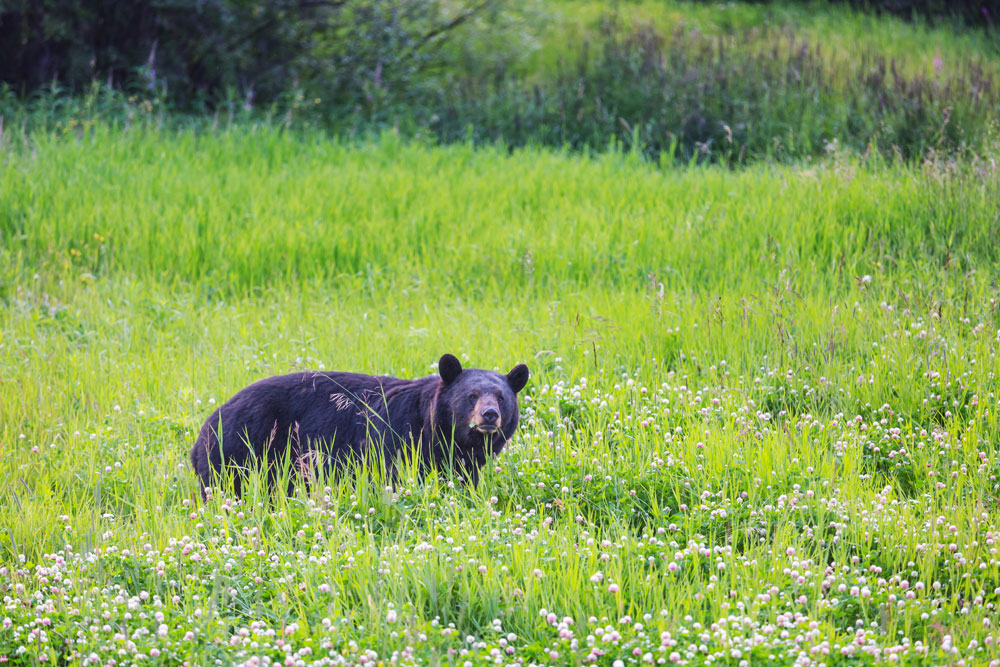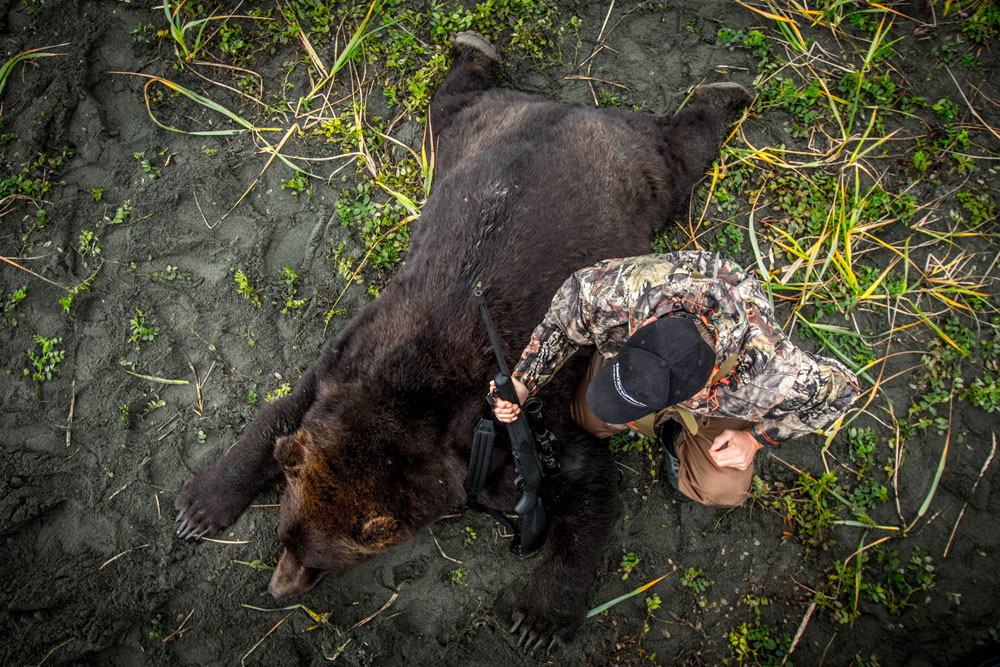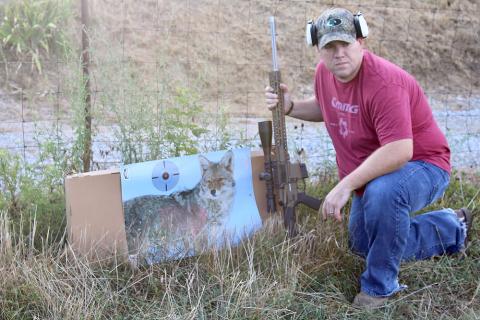Brad Fenson
There is something about hunting black bears that generates adrenaline in a hunter like no other big game. Perhaps it is the fact that a black bear could be the hunter, or fight back, which generates a new edge or fascination for the hunter.
Hunting black bears for nothing more than an opportunity to be in the great outdoors is enough for most. Hides are often used as rubs or tanned hides, and skulls are measured to determine trophy class, or status compared to other black bears.
The meat from a black bear is coveted in some circles and should never be overlooked as an incredible source of protein that makes superb table fare.
Here is a look into North American black bears and information on getting started on a hunt of your own.

Abundance and opportunity
Black bears occur across North America, from Florida and the Carolinas to the west coast, all the way up to Alaska and the Yukon. There is plenty of hunting opportunity, with many western states offering across-the-counter tags. North Carolina is well known for producing huge bears, and the people of New York state encounter black bears with regularity. Of course, Canada has robust populations, with old bears that can grow big in remote areas.
Who
If you are serious about hunting black bears, there are several states and provinces where you can purchase or apply for licenses. Most jurisdictions offer spring and fall seasons, but some jurisdictions only offer fall hunts. If you’re a black bear aficionado, you could hunt this big game animal for close to six months a year without missing a day.
Where to find bears
Bears are found in many habitat types, with stable populations in hardwood, pine and northern stretches of the boreal forest. They thrive in the foothills, mountains, and a good portion of the parkland and prairie, showing their adaptability to survive almost anywhere.
What is a black bear?
Black bears are omnivores, meaning they eat meat and vegetation, and are listed as a big game species in hunting regulations. They are the smallest of three bear species native to North America—the others being the grizzly and polar bears.
When to hunt

Many states and provinces offer a spring season for a black bear that can start as early as April and runs through June. Black bears breed in the spring, and late May to the end of June is a prime time to take advantage of big, old boars roaming to find receptive females. It is the one time of year the big, shy bears put down their guard and show up where they normally wouldn’t.
There are also fall black bear seasons, providing the opportunity to harvest a bear while hunting other big game.
Why hunt bears
Besides providing excellent recreational hunting opportunity, black bears are a great source of protein. Many early settlers in the west harvested black bears for meat, a tradition that continues today. The fat on a fall black bear can be rendered into lard and used for baking. Bear fat has also been used historically for waterproofing footwear and leather mittens.
Black bear hides have been used on garments as trim and accessories. Hides can be tanned and used as throw rugs, or used for car seats, crafts, or saved as a memento of a successful hunt.
Bear meat should be cooked well-done to ensure there isn’t a chance of getting trichinosis. It is recommended you cook bear until it has an internal temperature of 175-degrees Fahrenheit. Always use a meat probe, or thermometer to ensure you get the meat off the grill the second it hits the right temperature.
Bowhunting Black Bears
- How to Set Up Your Bow - Check the regulations where you’re hunting as there are poundage limits in some places. Practice at the distance you’re willing to shoot, usually not past 20 yards. And you want to make sure your bow is quiet.
- Broadheads for Bear Hunting - There’s no right or wrong option, but the fixed blades seem to penetrate better. Expandables make great entrance and exit holes that make it great for tracking. Just practice your accuracy over and over; that’s the main thing for taking a bear with your bow. You want a 1/8-inch cut or bigger either way.
- Shot Placement - A bear’s lungs are further back toward the ribs. You want to center your shot in the ribs. Avoid the shoulder area and don’t shoot when they’re laying or sitting down. An accurate shot is crucial to your success.
- Treestand or Ground Blind - Treestands give you a good view to know when something is coming. They provide good shot opportunities. Ground blinds are less flexible, but there are benefits. They protect from weather and help with scent control. They also help with bugs as you can keep them at bay with a Thermacell in the blind. There are pros and cons of each, just do your homework and practice for both setups.
- Blood Trailing Black Bears - How long should you wait to go in and track your bear after the shot? What should you look for to keep pursuing the bear, and when should you back out?
Skinning Steps: How to skin your black bear
1. Lay bear on its back, with arms and legs splayed. Begin an incision with your knife about two inches below the bottom of the jaw and continue cutting down the center line to the anus.
2. Next, skin the front legs by starting with an incision at the base of the large pad on one paw. Continue cutting down the center of the back of the leg, through the elbow, and then cut a straight line to the center of the chest. Skin out the other front leg in the same way, making sure to come down the leg and meet the chest incision in the same way as the first leg to keep both sides symmetrical.
3. Remove the front paws by making incisions around the wrist joint and manipulating the joint until the connective tissue separates. Skin the paws out later or let your taxidermist do it.
4. To skin out the back legs, hold the first leg straight up and make an incision at the base of the large pad on the paw. Continue cutting in a straight line from the heel of the pad to the anus.
5. Remove the back paws in the same manner as the front paws.
6. Continue cutting the hide away from the muscle until the entire hide is released. You can carefully skin out the head, which is like caping a deer, or cut the skull off where it meets the spine and let your taxidermist do the fine knife work.
7. If you have access to a freezer, fold the hide in half, skin sides together, roll it up and put it in the freezer. If not, you will need to skin the head and paws before salting the hide and letting it air dry it. Pour extra moisture off the hide as it pools and add more salt until the hide becomes stiff and there is no more visible moisture.
Cooking Black Bear
Recipe: Corned Bear
Ingredients:
- 4 to 5 lbs bear ham or backstrap
- 6 quarts cold water
- ½ cup coarse salt
- ½ cup curing salt (like Morton Tender Quick)
- ¼ cup brown sugar
- 12 black peppercorns
- 2 bay leaves
- 6 whole allspice
- 1 cinnamon stick
- 6 Tbsp pickling spice, divided
- 10 garlic cloves, crushed
Directions:
1. Place the water in a medium pot with the coarse salt, curing salt, and brown sugar to create the brine. Cook over high heat until the salt and sugar have dissolved. Remove from heat and let cool.
2. Place the bear meat in an extra-large zip-top bag and add the brine. Add the remaining ingredients and 3 tablespoons of the pickling spice. Seal the bag and lay flat inside a container just in case it leaks and refrigerate for five days. Check daily to make sure the meat is completely submerged and turn the bag over.
3. After five days, remove the meat and discard the brine. Rinse the meat well under cool water.
4. Place the meat into a large pot, cover with fresh water, and add the remaining 3 tablespoons of pickling spice. For added flavor, add 2 carrots, 2 celery stalks, and half an onion all coarsely chopped. Bring the water to a boil and reduce heat to simmer for 3 to 3 ½ hours.
5. Remove the bear meat from the pot and serve or let cool and slice thinly across the grain.
Recipe: Slow-Cooker Bear & Beans
Using a slow cooker, crockpot, or Camp Chef Dutch oven to cook your bear, will ensure it is cooked to the proper temperature and be extremely tender and flavorful. Pork or ham is often used when cooking beans, but bear meat is the perfect accompaniment for this slow-cooked dish.
Ingredients:
- 5 lbs bear roast
- 1 quart beef broth
- 2 lbs white navy beans, dried
- 6 cups of water
- 2, 14-oz cans crushed pineapple
- 2, 14-oz cans tomato sauce
- 1 cup molasses
- 1 large yellow onion, diced
- 6 garlic cloves, crushed
- 1 Tbsp black pepper
- 1 Tbsp smoked paprika
- 1 Tbsp cumin
- 1 Tbsp salt
Directions:
1. Prepare the bear meat by placing it in a Mossy Oak/Weston slow cooker and covering with beef broth. Cook on high for 4 to 6 hours, so the meat is tender enough to fall apart. Remove from the cooker and let cool, then chop fine.
2. Rinse beans in a colander under cold water. Put the beans in a slow-cooker or Dutch oven and cover with the water, or strained broth from cooking the bear. Cook on high for 1.5 hours, monitoring to ensure the beans don’t dry out completely. Add more water or broth if needed.
3. Add the pineapple, tomato sauce, molasses, onion, garlic, black pepper, smoked paprika, cumin, salt, and bear meat and stir well to combine.
4. Cook on high for 6 to 8 hours, allowing beans to simmer. Check beans for tenderness and serve when ready.
Black bear hindquarters make awesome, lean hams. Most butcher shops will cure and smoke bear hams, which can then be used to prepare a batch of beans.

Need wild game meat for a recipe you've been wanting to try? Check out GameKeeper Butchery. GameKeeper Butchery is dedicated to procuring the finest assortment and highest quality of specialty meats from the United States and around the world. Our commitment is to deliver the safest, freshest and most wholesome products.






























